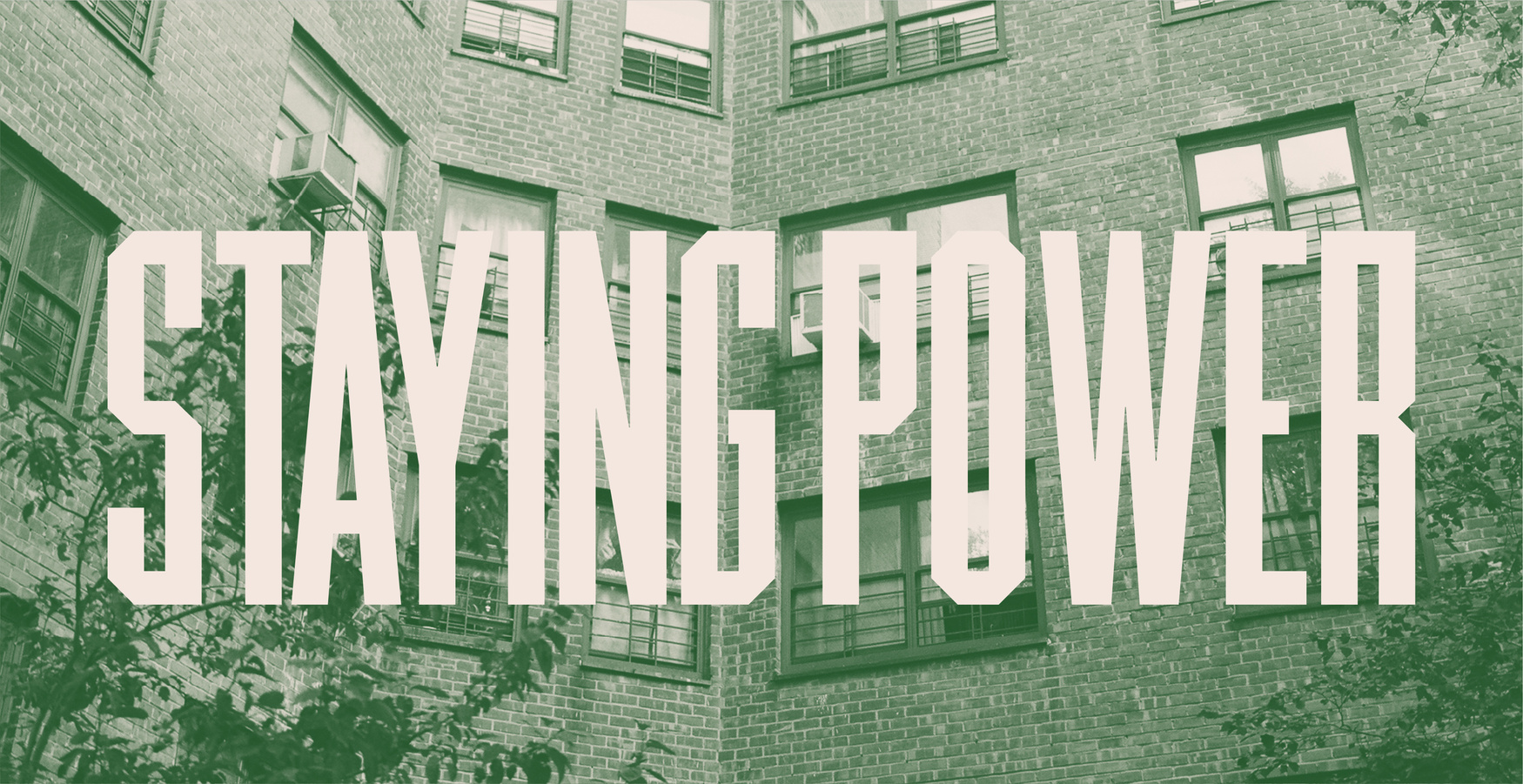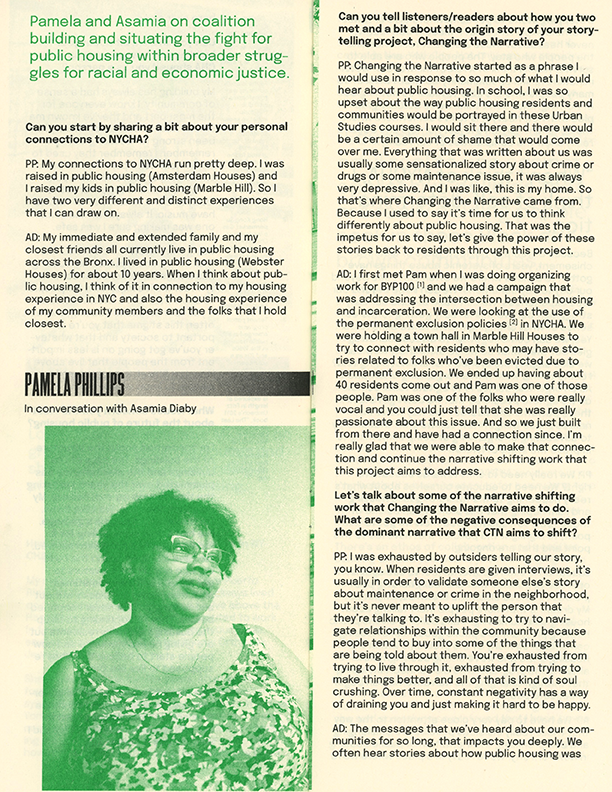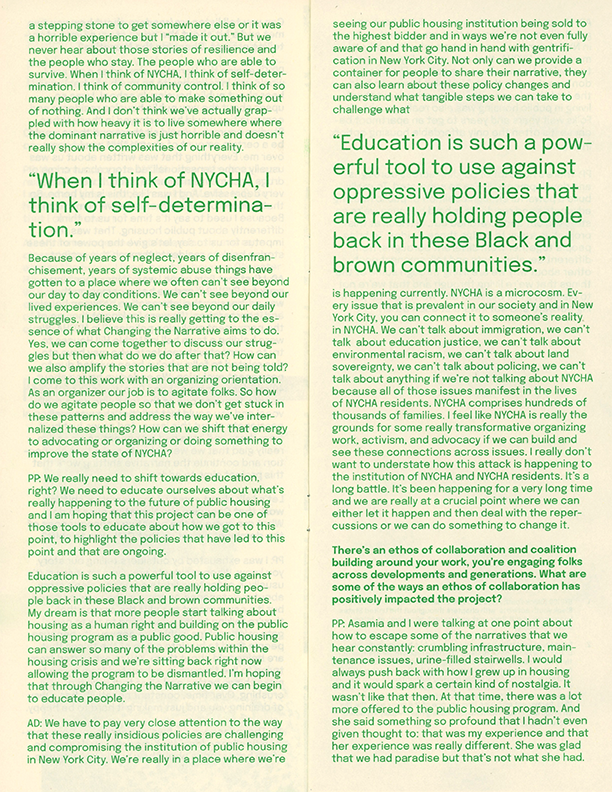STAYING POWER
Interview by Ayianna Kelley
Staying Power is a print and online publishing platform dedicated to amplifying a people’s history of public housing.
Ariana Faye Allensworth, an artist, designer, and cultural worker from San Francisco created the project “Staying Power”, which was made for uplifting the voices of those in public housing, and as stated by Allensworth herself, “amplifying a people’s history of public housing”. For those who are unaware, public housing is, in Allensworth’s words, “housing that is government owned and operated, and often requires residents to pay a fixed percentage of their household income. It provides a model of ensuring true housing affordability and housing security by protecting housing stocks from market-driven forces and sheltering the poor, disabled, working class, and seniors.” She also hopes to strip the public housing system of its negative stereotypes, which many hardworking Americans greatly rely on for housing and shelter. Without further ado, here is how the interview went.

Can you please explain what your project is, and what it is recorded on? (Ex. a poster, a book, a magazine, etc.)
The project takes place on the website Staying Power, which is considered an archive for the research used in the project including in depth history on public housing, but also more recent events surrounding the issue. It was also printed as a zine-styled booklet with the Secret Riso Club in 2022.
Did you grow up in housing? If so, what was your experience with it?
Although she did not grow up in public housing herself, Allensworth’s parents did for many years, and relied on it for stability.
What was the impetus behind starting up this project and creating this publishing platform?
One thing that she said was an inspiration for her project was the anti-eviction mapping project, a project that focuses on resisting gentrification in low-income neighborhoods. It also keeps information about public housing, other projects related to the topic, and how others can support the cause. The book “Black Exodus” was also a huge motivator, as it speaks on black migration after the civil war, and how many historically black neighborhoods came to be.
“I’ve been a long standing member of the Housing Justice Collective called the anti-eviction mapping project, which is a research and digital media project that focuses on documenting displacement and crafting tools for resistance in solidarity with gentrifying communities.” -Allensworth
When initially building out this publication, did you have any guiding principles in mind as to how to structure the content? What was your original vision?
Some goals at the beginning of the project were to inform, include, and distribute. She hopes to reach multiple audiences with this project, including public housing residents in a celebratory way, and non-residents in hopes that they will support the cause. She plans to do this by releasing her project through multiple forms of media such as physical zines, the website, and hopefully a documentary style video later down the line.
She also wanted to show that there is a negative stigma surrounding public housing, and to prove that public housing is not a bad thing, and the people relying on it are not lazy and incapable as the media portrays them to be. She wanted to include youth, and did this by interviewing students and colleagues in the public housing system to help gain insight for accuracy in her project.
Can you describe the process of seeking out interviewees and how you decided to center their stories in particular?
Getting interviewees was not hard according to Allensworth. She says that she interviewed many former students and colleagues, as she used to work in the education system and has many ties from there. Besides that, information about her project passed mostly by word of mouth, which was effective in getting many interviews from different perspectives, and adding diversity to the project. Some interviews were held remotely due to the pandemic, but she was able to do in person interviews once the quarantine was lifted.
She centered the stories around a history narrative format, and wanted the people to drive the narrative. She wanted to make sure she accurately depicted their thoughts in her project, and found this to be the best way to do so. In her interviews, she asked about the interviewees early life, family life, and how they came to New York as a little introduction. She then went into the interviewees' experiences by asking about how they got to that apartment, how long they lived there, and even asked about their opinions on the apartment itself.
“One of the reasons why I gravitated to oral history as an interview methodology is because it enables the narrator to self direct or guide what they share in the interview as opposed to a more journalistic style interview.”
Were there any common statements across your interviewers, or anything specific that stood out to you from any of them?
Some commonalities Allensworth saw throughout her interviews were that most residents also wanted to set the record straight in regards to the negative stereotypes of public housing. She said that despite the negativity surrounding it, she sensed a feeling of confidence from the people she interviewed.
Another thing she saw was brought up often was the decline in the upkeep and community in public housing, and a change in the vibe in general. They said people in the neighborhood do not give off the same feeling of family anymore, which is something they wish to bring back.
What might be some subjects you’d like to explore in additional volumes of Staying Power? How would you like to add to this project?
To add onto her current project, Allensworth said she would like to work on a project in California revolving around a region that was founded by her black ancestors that were former slaves. She said she would like to go into the history of the town while including examples of social housing and comparing it to her current project “Staying Power”. Unfortunately, the majority of the original residents have passed, so a lot of her research will be through archives, historians, and other activists with similar goals. She said she would like to one day make a documentary using said research to go with the project.
“I’m working on a project about Allensworth, California, which is a free black community which was founded by my ancestors in the early 1900s. It was the first town in California to be founded by and for black people, and it was self-governed for formerly enslaved and other free black people to live and thrive free from the forces of racism.”
Last words
Lastly, at the end of the interview, Allensworth decided to give a shout out to the organization “Save Section 9”, which is a non-profit organization with the goal of ending the privatization of public housing. A major problem for public housing residents is that public housing is slowly ending up in the hands of landlords, making it no longer public and not as reliable. Save Section 9 aims to stop this. Allensworth is asking you, as someone who has viewed her work and read this article, to help support them.
You can do this by clicking this link and following their instructions.
https://www.savesection9.org
“They are called ‘Save Section 9’ because currently public housing is funded under section 9, which is a type of housing, and privatization would shift it to section 8 housing, which would allow them to shift management to private landlords, leaving a lot to fear. So I would just amplify their work.”
The project takes place on the website Staying Power, which is considered an archive for the research used in the project including in depth history on public housing, but also more recent events surrounding the issue. It was also printed as a zine-styled booklet with the Secret Riso Club in 2022.
“The project is kind of envisioned as a multi-volume– an open edition sort of publication series, and so the first volume of the project, I released in spring 2022 in the format of a booklet/zine.”
Did you grow up in housing? If so, what was your experience with it?
Although she did not grow up in public housing herself, Allensworth’s parents did for many years, and relied on it for stability.
“A combination of public housing and section 8 housing vouchers are sort of what allowed them to be among the working part of San Francisco, but able to afford living in the city.”
What was the impetus behind starting up this project and creating this publishing platform?
One thing that she said was an inspiration for her project was the anti-eviction mapping project, a project that focuses on resisting gentrification in low-income neighborhoods. It also keeps information about public housing, other projects related to the topic, and how others can support the cause. The book “Black Exodus” was also a huge motivator, as it speaks on black migration after the civil war, and how many historically black neighborhoods came to be.
“I’ve been a long standing member of the Housing Justice Collective called the anti-eviction mapping project, which is a research and digital media project that focuses on documenting displacement and crafting tools for resistance in solidarity with gentrifying communities.” -Allensworth
When initially building out this publication, did you have any guiding principles in mind as to how to structure the content? What was your original vision?
Some goals at the beginning of the project were to inform, include, and distribute. She hopes to reach multiple audiences with this project, including public housing residents in a celebratory way, and non-residents in hopes that they will support the cause. She plans to do this by releasing her project through multiple forms of media such as physical zines, the website, and hopefully a documentary style video later down the line.
She also wanted to show that there is a negative stigma surrounding public housing, and to prove that public housing is not a bad thing, and the people relying on it are not lazy and incapable as the media portrays them to be. She wanted to include youth, and did this by interviewing students and colleagues in the public housing system to help gain insight for accuracy in her project.
“The stories in the zine really showcase stories of resilience and advocacy and joy and belonging that are often not like the stories you hear when public housing is covered in the news or media.”
Can you describe the process of seeking out interviewees and how you decided to center their stories in particular?
Getting interviewees was not hard according to Allensworth. She says that she interviewed many former students and colleagues, as she used to work in the education system and has many ties from there. Besides that, information about her project passed mostly by word of mouth, which was effective in getting many interviews from different perspectives, and adding diversity to the project. Some interviews were held remotely due to the pandemic, but she was able to do in person interviews once the quarantine was lifted.
She centered the stories around a history narrative format, and wanted the people to drive the narrative. She wanted to make sure she accurately depicted their thoughts in her project, and found this to be the best way to do so. In her interviews, she asked about the interviewees early life, family life, and how they came to New York as a little introduction. She then went into the interviewees' experiences by asking about how they got to that apartment, how long they lived there, and even asked about their opinions on the apartment itself.
“One of the reasons why I gravitated to oral history as an interview methodology is because it enables the narrator to self direct or guide what they share in the interview as opposed to a more journalistic style interview.”
Were there any common statements across your interviewers, or anything specific that stood out to you from any of them?
Some commonalities Allensworth saw throughout her interviews were that most residents also wanted to set the record straight in regards to the negative stereotypes of public housing. She said that despite the negativity surrounding it, she sensed a feeling of confidence from the people she interviewed.
Another thing she saw was brought up often was the decline in the upkeep and community in public housing, and a change in the vibe in general. They said people in the neighborhood do not give off the same feeling of family anymore, which is something they wish to bring back.
“I think everyone I interviewed gave voice to the experience of stereotypes about public housing residents, the impact that those stereotypes had on them, and their sense of confidence.”
What might be some subjects you’d like to explore in additional volumes of Staying Power? How would you like to add to this project?
To add onto her current project, Allensworth said she would like to work on a project in California revolving around a region that was founded by her black ancestors that were former slaves. She said she would like to go into the history of the town while including examples of social housing and comparing it to her current project “Staying Power”. Unfortunately, the majority of the original residents have passed, so a lot of her research will be through archives, historians, and other activists with similar goals. She said she would like to one day make a documentary using said research to go with the project.
“I’m working on a project about Allensworth, California, which is a free black community which was founded by my ancestors in the early 1900s. It was the first town in California to be founded by and for black people, and it was self-governed for formerly enslaved and other free black people to live and thrive free from the forces of racism.”
Last words
Lastly, at the end of the interview, Allensworth decided to give a shout out to the organization “Save Section 9”, which is a non-profit organization with the goal of ending the privatization of public housing. A major problem for public housing residents is that public housing is slowly ending up in the hands of landlords, making it no longer public and not as reliable. Save Section 9 aims to stop this. Allensworth is asking you, as someone who has viewed her work and read this article, to help support them.
You can do this by clicking this link and following their instructions.
Take Action — Section 9 is Public Housing
https://www.savesection9.org
“They are called ‘Save Section 9’ because currently public housing is funded under section 9, which is a type of housing, and privatization would shift it to section 8 housing, which would allow them to shift management to private landlords, leaving a lot to fear. So I would just amplify their work.”








